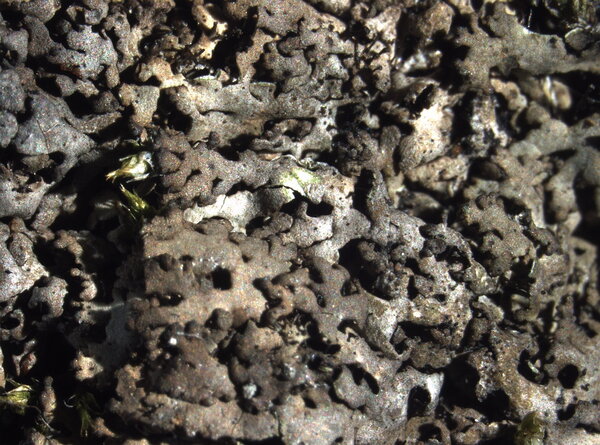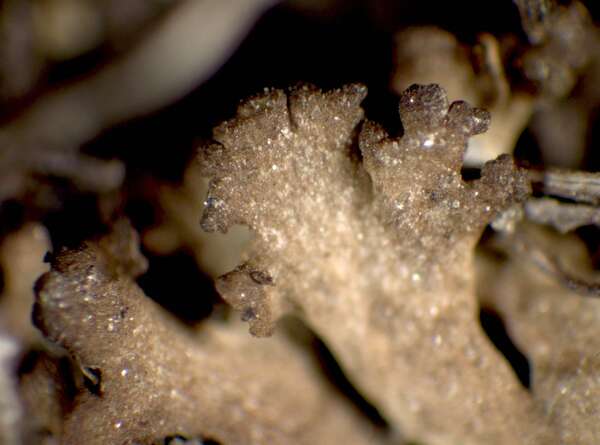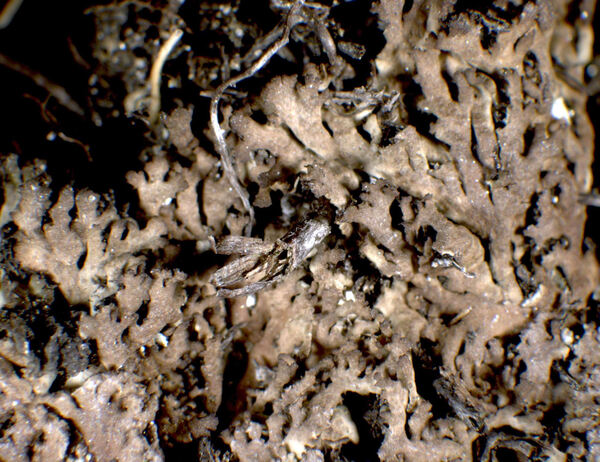Anaptychia bryorum Poelt
Bryologist, 74: 154, 1971.
Synonyms: Anaptychia aquila var. stippaea sensu Dalla Torre & Sarnth.; Anaptychia fusca var. stippaea auct.; Anaptychia stippaea (Ach.) Nádv sensu Nádv.; Kurokawia bryorum (Poelt) S.Y. Kondr., Lőkös & Hur
Description: Thallus foliose, heteromerous, dorsiventral, loosely attached. Lobes linear, flattened, smooth, ascending, often overlapping, 0.3-0.7(-1) mm broad and to 7 mm long, often with small (0.1-0.3 mm wide), ascending, mostly marginal adventitious lobules, the upper surface olive-brown to chestnut brown, darker in sun-forms, the lower surface whitish to pale brown, with a few sparse, mostly sparingly branched, pale to brown rhizines. Upper cortex prosoplectenchymatous, of conglutinated, thick-walled, periclinally arranged hyphae, overlain by a transparent layer of similar hyphae; medulla white; lower cortex prosoplectenchymatous but poorly developed, the hyphae running parallel to the surface. Apothecia not known. Photobiont chlorococcoid. Spot tests: cortex and medulla K- or K+ faintly yellow in the paler parts of thallus, C-, KC- or KC+ yellow, P-, UV-. Chemistry: without lichen substances or with variable amounts of variolaric acid (especially in the cortex) and zeorin.
Growth form: Foliose, narrow lobed
Substrata: soil, terricolous mosses, and plant debris
Photobiont: green algae other than Trentepohlia
Reproductive strategy: mainly sexual
Commonnes-rarity: (info)
Alpine belt: very rare
Subalpine belt: very rare
Montane belt: absent
Dry submediterranean belt: absent
Humid submediterranean belt: absent
Padanian area: absent
pH of the substrata:
1 2 3 4 5
Solar irradiation:
1 2 3 4 5
Aridity:
1 2 3 4 5
Eutrophication:
1 2 3 4 5
Poleotolerance:
0 1 2 3
Altitudinal distribution:
1 2 3 4 5 6
Rarity
absent
extremely rare
very rare
rare
rather rare
rather common
common
very common
extremely common
Loading data...
Occurrence data
Predictive map
Growth form: Foliose, narrow lobed
Substrata: soil, terricolous mosses, and plant debris
Photobiont: green algae other than Trentepohlia
Reproductive strategy: mainly sexual
Commonnes-rarity: (info)
Alpine belt: very rare
Subalpine belt: very rare
Montane belt: absent
Dry submediterranean belt: absent
Humid submediterranean belt: absent
Padanian area: absent
pH of the substrata:
| 1 | 2 | 3 | 4 | 5 |
Solar irradiation:
| 1 | 2 | 3 | 4 | 5 |
Aridity:
| 1 | 2 | 3 | 4 | 5 |
Eutrophication:
| 1 | 2 | 3 | 4 | 5 |
Poleotolerance:
| 0 | 1 | 2 | 3 |
Altitudinal distribution:
| 1 | 2 | 3 | 4 | 5 | 6 |
Rarity
absent
extremely rare
very rare
rare
rather rare
rather common
common
very common
extremely common
Loading data...
Occurrence data
Predictive map











